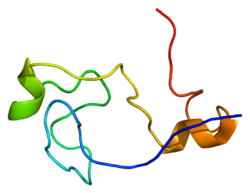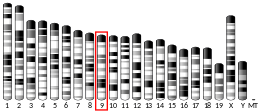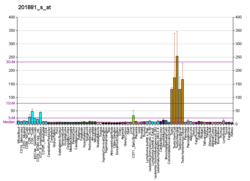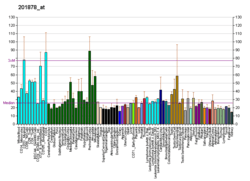ARIH1
Protein ariadne-1 homolog is a protein that in humans is encoded by the ARIH1 gene.[5][6]
Interactions
ARIH1 has been shown to interact with:
gollark: #we-need-@Traitor
gollark: #do-or-else
gollark: #admingollark
gollark: 🌵?
gollark: Most of any genre is bad.
References
- GRCh38: Ensembl release 89: ENSG00000166233 - Ensembl, May 2017
- GRCm38: Ensembl release 89: ENSMUSG00000025234 - Ensembl, May 2017
- "Human PubMed Reference:". National Center for Biotechnology Information, U.S. National Library of Medicine.
- "Mouse PubMed Reference:". National Center for Biotechnology Information, U.S. National Library of Medicine.
- Moynihan TP, Ardley HC, Nuber U, Rose SA, Jones PF, Markham AF, Scheffner M, Robinson PA (November 1999). "The ubiquitin-conjugating enzymes UbcH7 and UbcH8 interact with RING finger/IBR motif-containing domains of HHARI and H7-AP1". J Biol Chem. 274 (43): 30963–8. doi:10.1074/jbc.274.43.30963. PMID 10521492.
- "Entrez Gene: ARIH1 ariadne homolog, ubiquitin-conjugating enzyme E2 binding protein, 1 (Drosophila)".
- Tan NG, Ardley HC, Scott GB, Rose SA, Markham AF, Robinson PA (November 2003). "Human homologue of ariadne promotes the ubiquitylation of translation initiation factor 4E homologous protein, 4EHP". FEBS Lett. 554 (3): 501–4. doi:10.1016/s0014-5793(03)01235-3. PMID 14623119.
- Ardley HC, Tan NG, Rose SA, Markham AF, Robinson PA (June 2001). "Features of the parkin/ariadne-like ubiquitin ligase, HHARI, that regulate its interaction with the ubiquitin-conjugating enzyme, Ubch7". J. Biol. Chem. 276 (22): 19640–7. doi:10.1074/jbc.M011028200. PMID 11278816.
External links
- Human ARIH1 genome location and ARIH1 gene details page in the UCSC Genome Browser.
Further reading
- Aguilera M, Oliveros M, Martínez-Padrón M, Barbas JA, Ferrús A (2000). "Ariadne-1: a vital Drosophila gene is required in development and defines a new conserved family of ring-finger proteins". Genetics. 155 (3): 1231–44. PMC 1461160. PMID 10880484.
- Zhang Y, Redina O, Altshuller YM, Yamazaki M, Ramos J, Chneiweiss H, Kanaho Y, Frohman MA (2001). "Regulation of expression of phospholipase D1 and D2 by PEA-15, a novel protein that interacts with them". J. Biol. Chem. 275 (45): 35224–32. doi:10.1074/jbc.M003329200. PMID 10926929.
- Tan NG, Ardley HC, Rose SA, Leek JP, Markham AF, Robinson PA (2001). "Characterisation of the human and mouse orthologues of the Drosophila ariadne gene". Cytogenet. Cell Genet. 90 (3–4): 242–5. doi:10.1159/000056780. PMID 11124525.
- Stanchi F, Bertocco E, Toppo S, Dioguardi R, Simionati B, Cannata N, Zimbello R, Lanfranchi G, Valle G (2001). "Characterization of 16 novel human genes showing high similarity to yeast sequences". Yeast. 18 (1): 69–80. doi:10.1002/1097-0061(200101)18:1<69::AID-YEA647>3.0.CO;2-H. PMID 11124703.
- Ardley HC, Tan NG, Rose SA, Markham AF, Robinson PA (2001). "Features of the parkin/ariadne-like ubiquitin ligase, HHARI, that regulate its interaction with the ubiquitin-conjugating enzyme, Ubch7". J. Biol. Chem. 276 (22): 19640–7. doi:10.1074/jbc.M011028200. PMID 11278816.
- Wong ES, Fong CW, Lim J, Yusoff P, Low BC, Langdon WY, Guy GR (2002). "Sprouty2 attenuates epidermal growth factor receptor ubiquitylation and endocytosis, and consequently enhances Ras/ERK signalling". EMBO J. 21 (18): 4796–808. doi:10.1093/emboj/cdf493. PMC 126289. PMID 12234920.
- Tan NG, Ardley HC, Scott GB, Rose SA, Markham AF, Robinson PA (2003). "Human homologue of ariadne promotes the ubiquitylation of translation initiation factor 4E homologous protein, 4EHP". FEBS Lett. 554 (3): 501–4. doi:10.1016/S0014-5793(03)01235-3. PMID 14623119.
- Capili AD, Edghill EL, Wu K, Borden KL (2004). "Structure of the C-terminal RING finger from a RING-IBR-RING/TRIAD motif reveals a novel zinc-binding domain distinct from a RING". J. Mol. Biol. 340 (5): 1117–29. doi:10.1016/j.jmb.2004.05.035. PMID 15236971.
- Parelkar SS, Cadena JG, Kim C, Wang Z, Sugal R, Bentley B, Moral L, Ardley HC, Schwartz LM (2012). "The parkin-like human homolog of Drosophila ariadne-1 (HHARI) can induce aggresome formation in mammalian cells and is immunologically detectable in Lewy bodies". J. Mol. Neurosci. 46 (1): 109–21. doi:10.1007/s12031-011-9535-1. PMID 21590270.
This article is issued from Wikipedia. The text is licensed under Creative Commons - Attribution - Sharealike. Additional terms may apply for the media files.








